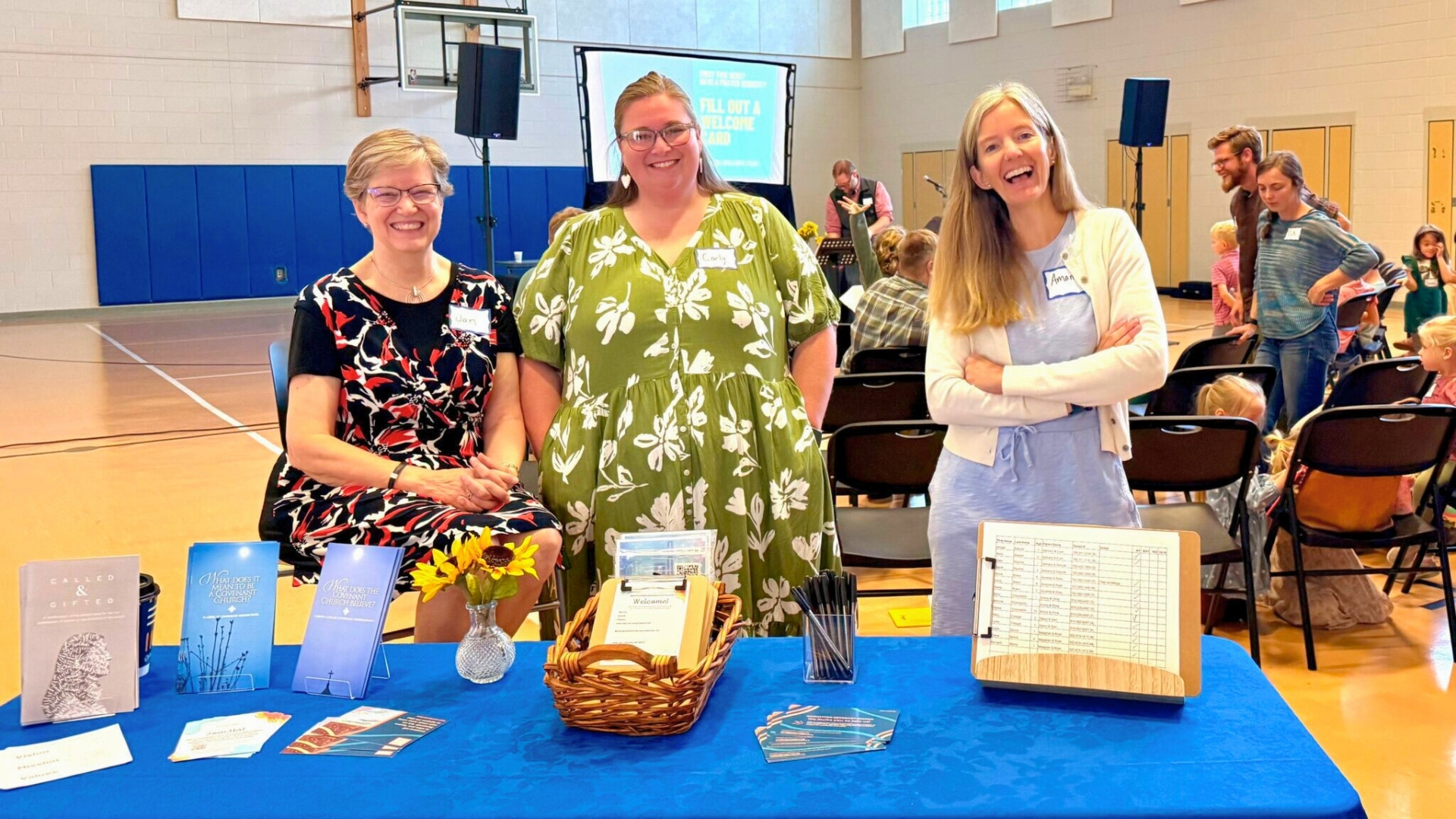
Stay With Me
Accepting Jesus’s Lenten Invitation to Vulnerability, Loss, and Grace
by Jan Bros | March 23, 2020
On Transfiguration Sunday at Abbey Way Covenant Church in Minneapolis, where I serve as pastor, we print the word “Alleluia” in large script on the back of the bulletin. In front of the altar, a small wooden chest sits on the floor with its lid opened, ready for what is to come. As worship ends, the sound of ripping paper fills the air as we tear the “alleluias” from our bulletins. Then one by one, each of us, young and old, places our “alleluia” inside the chest. When the procession concludes, the lid shuts. The word that now “cannot be named” is buried—suspended in use—for the liturgical season ahead.
The burying of the alleluia is a medieval tradition, which some say started as a counterbalance to the great “alleluias” of the Easter season. As we identify with Jesus’s 40-day fast in the wilderness, the discontinuance, or the deposition, of “alleluia” from liturgical prayer and song marks the beginning of the remembrance of the great paschal mystery of the dying and rising with Christ. It is a small fast, but significant in its embodying of the posture of the church’s walk to Easter.
I first encountered this practice through our children’s curriculum. On the first Sunday of Lent, the preschoolers receive a coloring sheet with a large “alleluia” that can be artfully engaged upon. The children’s “alleluias” are then buried in a large tub of sand or under a pile of large rocks and set in the corner of the room in wait for Easter Sunday. It is messy and physical as well as meaningful and fun. It teaches the children patience and persistence while helping to name the meaning of the liturgical season’s story.
Burying the alleluias is one way to embrace Lent. As a pastor, I recognize Lent contains a plethora of potent spiritual practices that help us move past our normal defense mechanisms and smuggle in the truth of the good news of Jesus in new ways.
I have loved Lent since I was a child. The wondrously strange and holy rituals and rites captivated my heart. From Pancake (or Shrove) Tuesday parties of sweet indulgences the day before Lent begins to the solemn washing of feet on Maundy Thursday, the width and breadth of experiences were visceral and experiential.
It was actually Lent—not Easter—that brought
solace to the gaping emptiness in my heart.
Growing up in a Catholic congregation that loved the repetition of sacred rhythm, I learned early that the season contained much fodder for engaging my imagination in the story of Jesus as he turned his face toward Jerusalem and ultimately the cross. Although a season of fasting and deprivation, Lent was a feast for the senses, year after year telling the same captivating story of the cost of the redemption of our souls. Yes, there were lots of smells and bells, but they all seemed to have a reason and purpose and left a mark on my soul.
I think there is something here for us. Too often, we shy away from some of these traditions, thinking they are archaic or overly religious. Yet in our culture that is so visual and sensual, embodying the story of Jesus helps us engage in it deeply.
A couple of years ago, my almost-four-year-old granddaughter flipped through a small book of art masterpieces that I place out on my coffee table during Lent. Page after page of paintings and drawings depict the crucifixion of Jesus through the hands of artists representing many different cultures and periods. She was only beginning to learn about his life and death, and at first I was nervous about the graphic depictions. Frankly, some of the images made me uncomfortable in the agony they conveyed. But as I sat and talked to her about what she saw, I saw that having a new dialogue partner about what was real and good helped us both draw a little nearer to Jesus and his story.
Maybe we avoid Lent in the same way our culture is prone to turn away from the face of suffering and death. We tend to jump ahead to claim that Jesus has already risen from the dead, freeing us from death’s sting. Perhaps taking six full weeks to sing “Lift High the Cross” in worship spaces garbed in purple feels overdone. But the women who stood at a distance on Calvary’s mount, their gaze fixed on our Lord’s pain and death, have something to teach us. Lent’s invitation is to stay with, to watch and pray. We need the weeks leading to Easter’s hope to show us our own vulnerability, to help us see we do not have life in our control.
I learned early that I did not have control. My mom died after a long struggle with cancer when I was in middle school. The grief of her death impacted every part of my being. It was actually Lent—not Easter—that brought solace to the gaping emptiness in my heart. When words failed me in my pain, I felt confident that the One who was called Jesus knew the ache I carried. As the story was told and retold of the slow walk to Jerusalem, the rage of Temple cleansing, the tenderness of anointing and washing, the bread broken and wine poured, the loneliness of night prayer, betrayal of friends, and ultimately pain and death, I found one who identified with me. The story became a place of encounter with a merciful God who knew me, making a way through pain and death to new life.
Time and time again, I entered a darkened sanctuary garbed in purple array. As opposed to the normative Christmas and Easter décor with its visual display of life, the sacred space during these cold months of winter was bare and empty. A sizable naked tree branch balanced in a simple pot and a life-size cross above the altar were the only symbols of the season. Strangely, they were enough. I would stare into the vacant space, and as the hallowed dark, suffering space reflected to me, it taught me over time to come near the loss I felt.
For those who have not experienced substantial seasons of personal suffering, Lent can afford God’s people with the spiritual practice of entering a liminal space of holy hope. The conscious embrace of the uncertain and uncomfortable, as revealed through the story of Jesus, helps expand our understanding of Jesus’s resurrection and ascension. The late Robert E. Webber wrote in Ancient-Future Faith: Rethinking Evangelicalism for a Post-Modern World, “In this way worship is the rehearsal of the Christ event through which one’s experience with God is established, maintained, and repaired.”
Sacred embodiment creates a vessel for God’s Spirit to teach essential skills and capacities for life. From the ashen cross on our foreheads to the dark, empty void of Good Friday, we need these embodied experiences and the full range of the gospel story to teach us how to reside with faith in the uncomfortable parts of our own story and the incompleteness of our world.
As we proclaim the words,
“He is risen!” they open the lid.
The pieces of torn bulletin paper
have been transformed into white
“Alleluia” ribbons, given out by the
children in handfuls to everyone gathered.
Lent gives us tangible ways to identify with the life of Christ. Yes, the story may be familiar, but the active engagement of our whole selves makes Lent a holy teacher. The traditional Lenten spiritual disciplines of almsgiving, fasting, and prayer become the road we travel through the liturgical season. Thinking of the other, restraining from certain foods or activities, and engaging in particular prayer practices can help to open our souls to God and away from self-centered choices.
Slowing down to turn away from our relentless pace and activities, even if only for a few moments each day, can create opportunities to enter into God’s grace anew.
Yet to disengage is not enough. We must not forget the beauty of the corporate worship afforded us during Lent. The hymns, liturgies, artwork, silence, prayers, and rituals—those that are both familiar and unfamiliar—can be freshly reinvigorated as places of encounter with God and others in the community of faith. Let us not be afraid of embracing this season with our whole selves in all its peculiarity. Attend all the services, not only the ones we like or are comfortable with. Walk the entire journey, not just a part. Yes, Lent may invite us to explore new practices, but they are trustworthy and can be found to be bearers of truth and healing.
On Easter morning at Abbey Way, the wooden box is processed up to the front of our worship space by someone from the congregation. As we proclaim the words, “He is risen!” they open the lid. The pieces of torn bulletin paper have been transformed into white “Alleluia” ribbons, given out by the children in handfuls to everyone gathered. That which was buried is now waved with joy for those who sing “Christ the Lord Is Risen Today.” The beauty and glory of the dying and rising of Christ is now mysteriously embodied in the church. That which has been once buried is alive.
About the Author
Jan Bros serves as lead pastor of Abbey Way Covenant Church in Minneapolis, Minnesota, and is also a spiritual director and mentor to female clergy. She loves to travel, hike, bike, quilt, and play with her grandkids.













